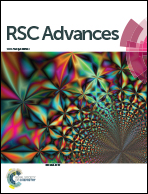Direct insight into the nonclassical hydrophobic effect in bile salt:β-cyclodextrin interaction: role of hydrophobicity in governing the prototropism of a biological photosensitizer†
Abstract
The interaction of a potent cancer cell photosensitizer, norharmane (NHM) with a series of bile salt aggregates of varying hydrophobicity e.g., sodium deoxycholate (NaDC), sodium cholate (NaC), and sodium taurocholate (NaTC) is investigated. Our spectroscopic results unveil the remarkable modulation of the prototropic equilibrium of NHM within the bile salt aggregates, which is notably favored toward the neutral species of NHM over the cationic counterpart; the results have been aptly rationalized based on the key role of hydrophobic interaction and are reinforced from time-resolved measurements with emphasis on rotational relaxation dynamics. Furthermore, the present work reveals the application of β-cyclodextrin as a potential host for releasing the bile salt-encapsulated drug through an inclusion complex formation with the bile salt monomers. An extensive thermodynamic analysis of the bile salt:βCD inclusion complex formation reveals that the phenomenon is characterized by a dominant enthalpic contribution interpreted on the grounds of “nonclassical” hydrophobic effect, contrary to the conventional case of entropy-driven classical hydrophobic effect.


 Please wait while we load your content...
Please wait while we load your content...